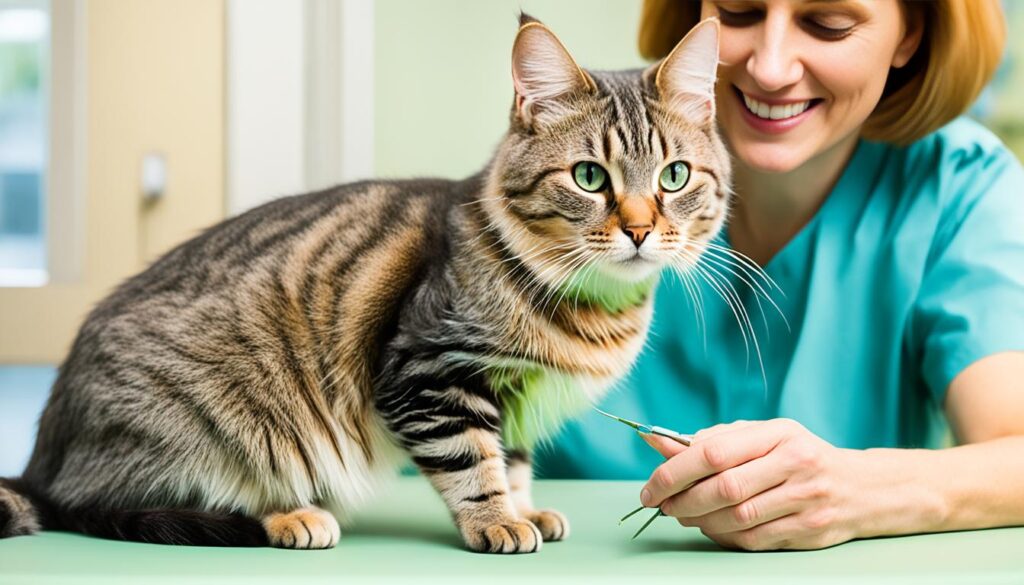Did you know that aggressive cat behavior is a common issue that affects a significant number of feline companions? Aggression in cats can range from hissing and growling to full-blown attacks, posing risks to the safety of both humans and other animals.
Understanding the underlying causes and effectively managing aggressive behavior in cats is crucial for maintaining a harmonious home environment. In this article, I will provide valuable tips and insights on how to handle aggressive cats, decipher their body language, and address the root causes of their aggression.
Key Takeaways:
- Aggressive behavior is common in cats and can range from mild to severe aggression.
- Recognizing cat body language is essential for identifying signs of aggression.
- Different types of aggression, such as fear aggression and play aggression, require tailored management approaches.
- Addressing the underlying causes of aggression, including medical issues and environmental changes, is crucial.
- Calming techniques, behavior modification, and professional guidance can help in managing and resolving aggressive behavior.
What Is Aggression?
Aggression is a natural and instinctive behavior displayed by cats that can encompass a range of threatening or harmful actions towards people, other cats, or other animals. It is a complex behavior that can have different triggers and occur in various circumstances.
Aggressive behavior in cats can manifest in different ways, from hissing and avoidance to more severe acts of aggression, such as scratching or biting. Understanding the types of aggression and the underlying motivations behind each behavior is essential in effectively addressing and managing aggressive behavior in cats.
Cats are known to exhibit aggression as a means of self-defense and protecting their territory. It is a survival instinct deeply ingrained in their nature. However, when aggression becomes excessive or inappropriate, it can pose a threat to the safety and well-being of both humans and animals.
Addressing and managing aggressive behavior in cats requires an understanding of the underlying causes and triggers. It is crucial to intervene to prevent potential harm and provide a safe environment for all parties involved.
Understanding the complex nature of cat aggression can help cat owners respond effectively to aggressive behavior and promote a harmonious living environment.
Understanding Cat Body Language
Cats have a rich and nuanced way of communicating, and much of it is expressed through their body language. Understanding cat body language is essential for cat owners to accurately interpret their cat’s feelings and motivations. By being attuned to their postures, facial expressions, and the positions of their ears, tail, and whiskers, we can gain valuable insights into what our feline companions are trying to communicate.
Defensive Postures
When a cat feels threatened or fearful, they may adopt defensive postures as a way to protect themselves. These postures include:
- Crouching
- Head tucking
- Flattened ears
In addition to these physical postures, defensive cats may also exhibit defensive signals like hissing and spitting. These behaviors serve as clear warnings to intruders or potential threats.
Offensive Postures
Cats can also display offensive postures when they are in an aggressive or confrontational state. These postures are intended to convey dominance and establish boundaries. Offensive postures may include:
- Stiff upright stance
- Raised rear end
- Direct stare
Growling or yowling may accompany these offensive postures, further emphasizing their intent to challenge or intimidate.
Recognizing and respecting these signs of cat body language is crucial for avoiding potential aggression and ensuring a safe and peaceful environment for both cats and humans.
| Posture | Meaning |
|---|---|
| Crouching | Indicates fear or submission |
| Head tucking | Shows extreme fear or submission |
| Flattened ears | Signifies fear or aggression |
| Stiff upright stance | Displays aggression and dominance |
| Raised rear end | Indicates readiness to attack |
| Direct stare | Conveys assertiveness or aggression |
| Growling or yowling | Accompanies offensive postures as an audible warning |
Classification of Aggressive Behavior
Understanding the classification of aggressive behavior in cats is essential in developing effective strategies to address and manage the problem. Aggression in cats can be influenced by various medical conditions, such as toxoplasmosis, hyperthyroidism, dental disease, and trauma. To ensure a comprehensive approach, it is important to conduct a complete veterinary evaluation to rule out any underlying medical issues that may contribute to the aggressive behavior. Once medical conditions have been addressed, it becomes crucial to identify the specific type of aggression a cat displays and its triggers.
Aggressive behavior in cats can be classified based on its function or purpose. Here are some common types of aggression:
- Aggression between cats: This occurs when cats display aggressive behavior towards other cats in the household, often due to territorial conflicts or competition for resources.
- Fear aggression: Cats may exhibit aggressive behavior when they feel threatened or scared. This can happen in response to unfamiliar people, animals, or situations.
- Territorial aggression: Cats are naturally territorial, and they may become aggressive when they perceive their territory is being invaded or encroached upon by other animals or humans.
- Play aggression: Cats engage in play behaviors that can sometimes become aggressive, with biting and scratching. This type of aggression is usually seen in young cats and kittens.
- Redirected aggression: This occurs when a cat is unable to direct its aggression towards the perceived threat and instead redirects it towards another target, such as a cat owner or another pet.
- Status-induced aggression: Aggression can arise in situations where one cat is trying to assert dominance over another cat, especially if resources are limited.
Identifying the specific type of aggression and its triggers is crucial in implementing appropriate strategies to manage and address the behavior. With a comprehensive understanding of the classification of aggressive behavior and its underlying causes, cat owners can work towards creating a safe and harmonious environment for their feline companions.
| Type of Aggression | Description |
|---|---|
| Aggression between cats | Aggressive behavior displayed towards other cats in the household due to territorial conflicts or competition for resources. |
| Fear aggression | Aggressive behavior displayed when a cat feels threatened or scared, often in response to unfamiliar people, animals, or situations. |
| Territorial aggression | Aggressive behavior displayed when a cat perceives its territory is being invaded or encroached upon by other animals or humans. |
| Play aggression | Aggressive behavior displayed during play, often seen in young cats and kittens. |
| Redirected aggression | Aggressive behavior directed towards a target other than the perceived threat, commonly seen when a cat is unable to direct its aggression towards the source of the provocation. |
| Status-induced aggression | Aggressive behavior arising from situations where one cat tries to assert dominance over another cat, particularly when resources are limited. |
Signs of Aggression in Cats

Cats communicate their feelings through a combination of body language, vocal cues, and physical contact. Understanding and recognizing these signs is crucial in determining when a cat is feeling threatened or anxious, and on the verge of aggressive behavior. By being attentive to these signals, cat owners can prevent incidents of aggression and promote a harmonious relationship with their feline companions.
Visual Cues
Cats display various visual cues that indicate aggression:
| Signs | Description |
|---|---|
| Dilated Pupils | Enlarged pupils indicate heightened arousal and potential aggression. |
| Flattened Ears | Ears pressed tightly against the head signal defensive or offensive aggression. |
| Puffed-Up Tail | A raised, puffed-up tail is a sign of aggression and readiness to defend. |
| Crouching or Arched Back | Cats may crouch low to the ground or arch their backs in an aggressive posture. |
Vocal Cues
Cats use vocalizations to communicate their aggression:
- Growling or Hissing: A low growl or hiss typically indicates anger or distress.
- Yowling: A loud, intense yowl can be a warning sign of aggression.
Physical Contact
Physical contact can escalate during aggressive episodes:
- Swatting or Scratching: Cats may use their claws to swipe or scratch when agitated.
- Biting: Aggressive cats may resort to biting as a defensive or offensive measure.
Understanding these signs of aggression allows cat owners to respond appropriately and diffuse potential conflicts. By being attentive and proactive in interpreting a cat’s behavior, owners can intervene early and prevent aggressive incidents from occurring. It is important to create a safe and stress-free environment for both the cat and those around them.
Types of Cat Aggression
Understanding the different types of aggression in cats is crucial for effectively managing and modifying their behavior. By identifying the specific type of aggression, cat owners can develop targeted strategies to address the underlying causes and create a safe environment for both their feline companions and themselves.
1. Play Aggression
Play aggression is a common type of aggression in cats, especially among younger individuals. During play sessions, cats may display rough play behaviors that can escalate to biting and scratching. While this behavior is a natural part of feline play, it is important to redirect their play towards appropriate toys and provide regular opportunities for physical and mental stimulation.
2. Fear Aggression
Fear aggression occurs when a cat feels threatened or trapped and responds aggressively to defend themselves. This can happen in situations such as encountering unfamiliar people, animals, or being in unfamiliar environments. It is essential to create a safe and secure space for fearful cats and gradually expose them to new stimuli in a controlled and positive way.
3. Petting-Induced Aggression
Petting-induced aggression can occur when a cat becomes overstimulated during petting or does not want to be petted. Some cats have a threshold for physical contact, and exceeding that threshold can lead to aggression. It is important to pay attention to a cat’s body language and signs of discomfort during petting sessions. Allowing cats to initiate and control physical contact can help prevent petting-induced aggression.
4. Territorial Aggression
Territorial aggression is rooted in a cat’s instinct to protect their territory. Cats may display aggressive behaviors when they perceive their territory is being encroached upon, either by other pets or people. Providing cats with designated spaces and resources can help reduce territorial aggression. Additionally, gradual introductions and positive associations with new individuals or pets can help minimize territorial conflicts.
Understanding and addressing the specific type of aggression is crucial in effectively managing and modifying cat behavior. By implementing appropriate strategies and providing a supportive environment, cat owners can help their feline companions lead happier, healthier lives.
| Type of Cat Aggression | Description |
|---|---|
| Play Aggression | Cats engage in rough play that can escalate to biting and scratching. |
| Fear Aggression | Cats respond aggressively when they feel threatened or trapped. |
| Petting-Induced Aggression | Cats become overstimulated during petting or do not want to be petted. |
| Territorial Aggression | Cats display aggressive behaviors to protect their territory. |
Calming Aggressive Cats

Calming aggressive cats often requires a multifaceted approach. It’s important to consider various strategies and techniques to effectively manage and modify their behavior.
Environmental Enrichment
One effective method in calming aggressive cats is environmental enrichment. Providing additional perches and hiding spots allows cats to feel more secure and have a sense of control over their surroundings. It’s also crucial to ensure an adequate supply of resources, such as food, water, litter boxes, and scratching posts, to prevent competition and reduce stress.
Reinforcing Incompatible Behaviors
Another strategy is reinforcing incompatible behaviors. By teaching your cat alternative actions that are incompatible with aggression, it can redirect their energy and focus. For instance, rewarding calm and relaxed behavior with treats or playtime can help condition positive responses.
Calming Products
Certain calming products, like pheromones, can help reduce aggression in cats. Synthetic pheromones mimic the natural calming scents that cats release, promoting a sense of safety and relaxation. Diffusers, sprays, or collars infused with these pheromones can be used in the cat’s environment to create a calming atmosphere.
Behavior Modification Techniques
Behavior modification techniques, such as desensitization and counterconditioning, can be effective in reducing aggressive behavior. Desensitization involves gradually exposing the cat to stimuli that trigger aggression, starting at a low intensity and gradually increasing it over time. Counterconditioning focuses on changing the cat’s emotional response to the trigger by associating it with something positive, like treats or play.
Professional Guidance
In severe cases or when previous strategies have been ineffective, seeking professional guidance from a Certified Applied Animal Behaviorist or a board-certified veterinary behaviorist is recommended. These professionals have the expertise and experience to develop and implement a comprehensive behavior modification plan tailored to your cat’s specific needs.
Remember, managing aggression in cats requires patience, consistency, and a thorough understanding of the underlying causes. By implementing these strategies and seeking professional guidance if necessary, you can create a safe and harmonious environment for both your aggressive cat and yourself.
Why Is My Cat Aggressive?
Aggression in cats can have various underlying causes, including underlying medical conditions, sudden changes in behavior, pain, and environmental factors. It is essential to rule out any medical issues that may be causing or contributing to the aggression. Sudden aggression can be a result of pain, such as dental problems or injuries. Environmental changes, such as moving to a new location or introducing new pets or people into the household, can also trigger aggressive behavior in cats. Understanding the specific triggers and addressing the underlying causes can help in managing and resolving the aggression.
When it comes to aggression in cats, underlying medical conditions can play a significant role. Cats may display aggressive behavior due to certain health issues, such as hyperthyroidism or dental disease. It is crucial to have your cat examined by a veterinarian to rule out any possible medical problems that may be causing or contributing to their aggressive behavior. Only after addressing these underlying medical conditions can you effectively manage the aggression.
Sudden changes in behavior can also be a factor in your cat’s aggression. Cats are creatures of habit, and any disruption to their routine or environment can cause stress and anxiety. This, in turn, can lead to aggressive behavior as a means of self-defense or territorial protection. For example, if you have recently moved to a new home or introduced a new pet or person into the household, your cat may feel threatened and express their aggression. Providing a stable and predictable environment for your cat can help alleviate their aggression and promote a sense of security.
Pain is another common cause of aggression in cats. Cats are masters at hiding their pain, and aggression can be their way of expressing discomfort. Dental problems, injuries, or underlying medical conditions can all cause pain and trigger aggressive behavior in cats. If your cat suddenly becomes aggressive, it is crucial to have them evaluated by a veterinarian to rule out any possibility of pain or discomfort.
Environmental changes can also be a significant contributing factor to your cat’s aggression. Cats are highly sensitive to their surroundings, and any disruption to their environment can stress them out and lead to aggressive behavior. Changes such as rearranging furniture, introducing new furniture, or even changes in household routines can unsettle your cat and provoke aggression. Providing your cat with a stable and enriched environment, with plenty of hiding spots, scratching posts, and interactive toys, can help reduce their stress levels and prevent aggression.
To summarize, aggression in cats can have various underlying causes, including medical conditions, sudden changes in behavior, pain, and environmental factors. It is essential to address these factors and understand the specific triggers to effectively manage and resolve your cat’s aggression.
| Underlying Causes of Cat Aggression | Examples |
|---|---|
| Medical Conditions | Hyperthyroidism, dental disease |
| Sudden Changes in Behavior | Moving to a new location, introducing new pets or people |
| Pain | Dental problems, injuries |
| Environmental Changes | Changes in household routine, rearranging furniture |
Conclusion
Aggressive behavior in cats is a common issue that can be concerning for cat owners. Understanding the different types of aggression, recognizing the signs, and addressing the underlying causes are crucial in managing and modifying aggressive cat behavior. By implementing behavior modification techniques, providing environmental enrichment, and seeking professional guidance when necessary, cat owners can create a safe and harmonious home environment for both their feline companions and themselves.
Behavior modification plays a key role in addressing aggressive cat behavior. Techniques such as desensitization and counterconditioning can help cats learn more appropriate responses to triggers that may have previously provoked aggression. It is essential to be patient, consistent, and diligent throughout the behavior modification process, as it takes time for cats to unlearn old habits and develop new, more desirable behaviors.
Understanding feline aggression requires a holistic approach that addresses both the physical and emotional needs of cats. Environmental enrichment, such as providing ample opportunities for play, exercise, and mental stimulation, can help cats release pent-up energy in a more positive way. Additionally, creating a calm and stress-free environment by minimizing sudden changes, providing safe spaces, and ensuring access to resources can help reduce anxiety and prevent aggressive behavior.







